Business Administration Project Report: Tesco's Project Management
VerifiedAdded on 2020/10/22
|13
|4421
|460
Report
AI Summary
This report delves into the core aspects of project management within a business administration context, using Tesco as a case study. It begins by explaining the process of cost-benefit analysis and evaluating various risk analysis techniques. The report further examines project planning and management tools, assessing the impact of changes on project scope, schedule, finances, risks, quality, and resources. It analyzes the requirements of project governance arrangements and how a project aligns with an organization's vision, objectives, and plans. The report also covers the development of project plans with key performance indicators, risk management strategies, and the application of project life cycle approaches. It then addresses resource allocation, team member roles, plan implementation, and stakeholder communication. The report concludes with an analysis of project reviews and knowledge management, providing a comprehensive overview of project management principles and their practical application.

BUSINESS
ADMINISTRATION
(58)
ADMINISTRATION
(58)
Paraphrase This Document
Need a fresh take? Get an instant paraphrase of this document with our AI Paraphraser
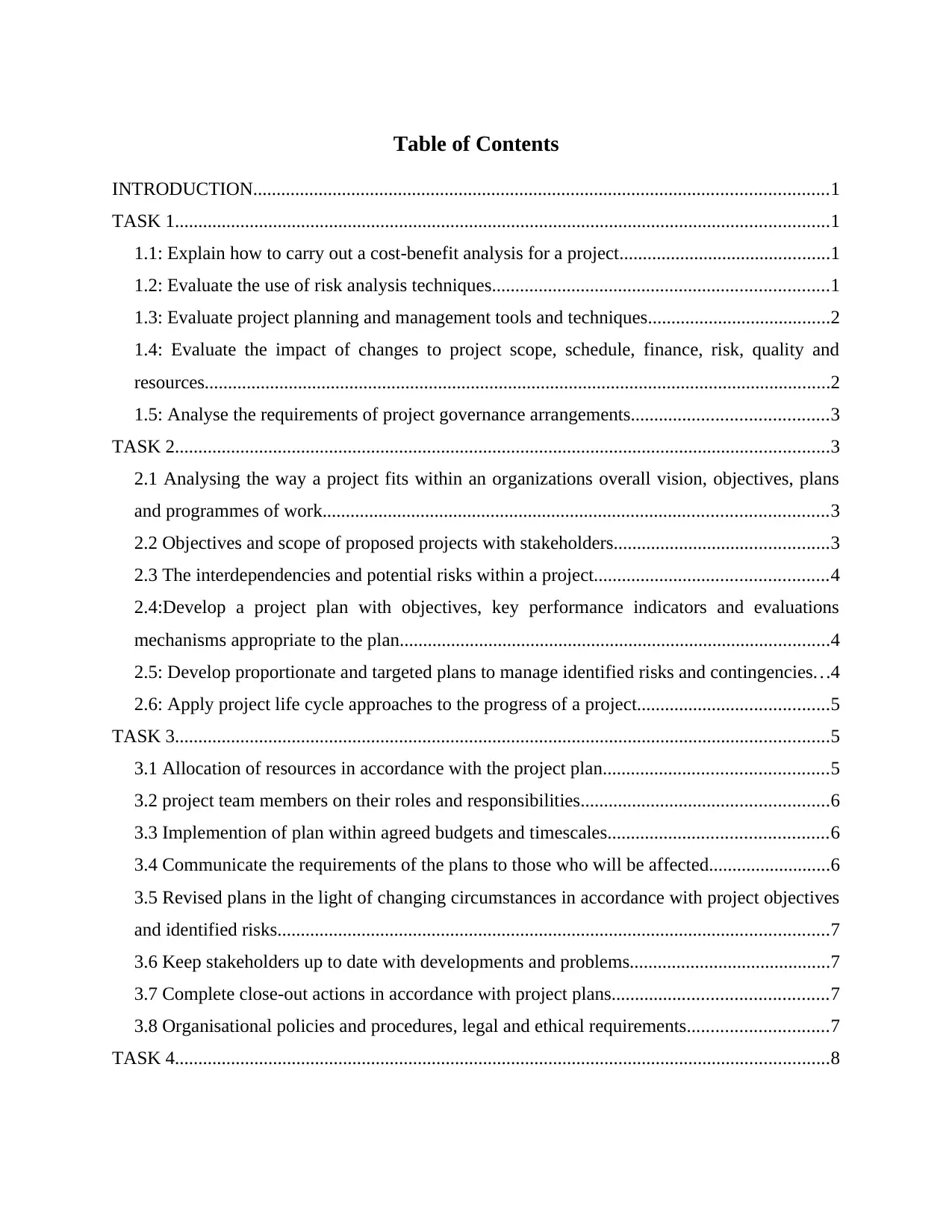
Table of Contents
INTRODUCTION...........................................................................................................................1
TASK 1............................................................................................................................................1
1.1: Explain how to carry out a cost-benefit analysis for a project.............................................1
1.2: Evaluate the use of risk analysis techniques........................................................................1
1.3: Evaluate project planning and management tools and techniques.......................................2
1.4: Evaluate the impact of changes to project scope, schedule, finance, risk, quality and
resources......................................................................................................................................2
1.5: Analyse the requirements of project governance arrangements..........................................3
TASK 2............................................................................................................................................3
2.1 Analysing the way a project fits within an organizations overall vision, objectives, plans
and programmes of work............................................................................................................3
2.2 Objectives and scope of proposed projects with stakeholders..............................................3
2.3 The interdependencies and potential risks within a project..................................................4
2.4:Develop a project plan with objectives, key performance indicators and evaluations
mechanisms appropriate to the plan............................................................................................4
2.5: Develop proportionate and targeted plans to manage identified risks and contingencies...4
2.6: Apply project life cycle approaches to the progress of a project.........................................5
TASK 3............................................................................................................................................5
3.1 Allocation of resources in accordance with the project plan................................................5
3.2 project team members on their roles and responsibilities.....................................................6
3.3 Implemention of plan within agreed budgets and timescales...............................................6
3.4 Communicate the requirements of the plans to those who will be affected..........................6
3.5 Revised plans in the light of changing circumstances in accordance with project objectives
and identified risks......................................................................................................................7
3.6 Keep stakeholders up to date with developments and problems...........................................7
3.7 Complete close-out actions in accordance with project plans..............................................7
3.8 Organisational policies and procedures, legal and ethical requirements..............................7
TASK 4............................................................................................................................................8
INTRODUCTION...........................................................................................................................1
TASK 1............................................................................................................................................1
1.1: Explain how to carry out a cost-benefit analysis for a project.............................................1
1.2: Evaluate the use of risk analysis techniques........................................................................1
1.3: Evaluate project planning and management tools and techniques.......................................2
1.4: Evaluate the impact of changes to project scope, schedule, finance, risk, quality and
resources......................................................................................................................................2
1.5: Analyse the requirements of project governance arrangements..........................................3
TASK 2............................................................................................................................................3
2.1 Analysing the way a project fits within an organizations overall vision, objectives, plans
and programmes of work............................................................................................................3
2.2 Objectives and scope of proposed projects with stakeholders..............................................3
2.3 The interdependencies and potential risks within a project..................................................4
2.4:Develop a project plan with objectives, key performance indicators and evaluations
mechanisms appropriate to the plan............................................................................................4
2.5: Develop proportionate and targeted plans to manage identified risks and contingencies...4
2.6: Apply project life cycle approaches to the progress of a project.........................................5
TASK 3............................................................................................................................................5
3.1 Allocation of resources in accordance with the project plan................................................5
3.2 project team members on their roles and responsibilities.....................................................6
3.3 Implemention of plan within agreed budgets and timescales...............................................6
3.4 Communicate the requirements of the plans to those who will be affected..........................6
3.5 Revised plans in the light of changing circumstances in accordance with project objectives
and identified risks......................................................................................................................7
3.6 Keep stakeholders up to date with developments and problems...........................................7
3.7 Complete close-out actions in accordance with project plans..............................................7
3.8 Organisational policies and procedures, legal and ethical requirements..............................7
TASK 4............................................................................................................................................8

4.1 Periodic reviews of the progress and effectiveness of a project using information from a
range of sources...........................................................................................................................8
4.2 Effectiveness of capturing and managing project-related knowledge.................................8
4.3 Report on the effectiveness of plans.....................................................................................9
CONCLUSION ...............................................................................................................................9
REFERENCES..............................................................................................................................10
range of sources...........................................................................................................................8
4.2 Effectiveness of capturing and managing project-related knowledge.................................8
4.3 Report on the effectiveness of plans.....................................................................................9
CONCLUSION ...............................................................................................................................9
REFERENCES..............................................................................................................................10
⊘ This is a preview!⊘
Do you want full access?
Subscribe today to unlock all pages.

Trusted by 1+ million students worldwide
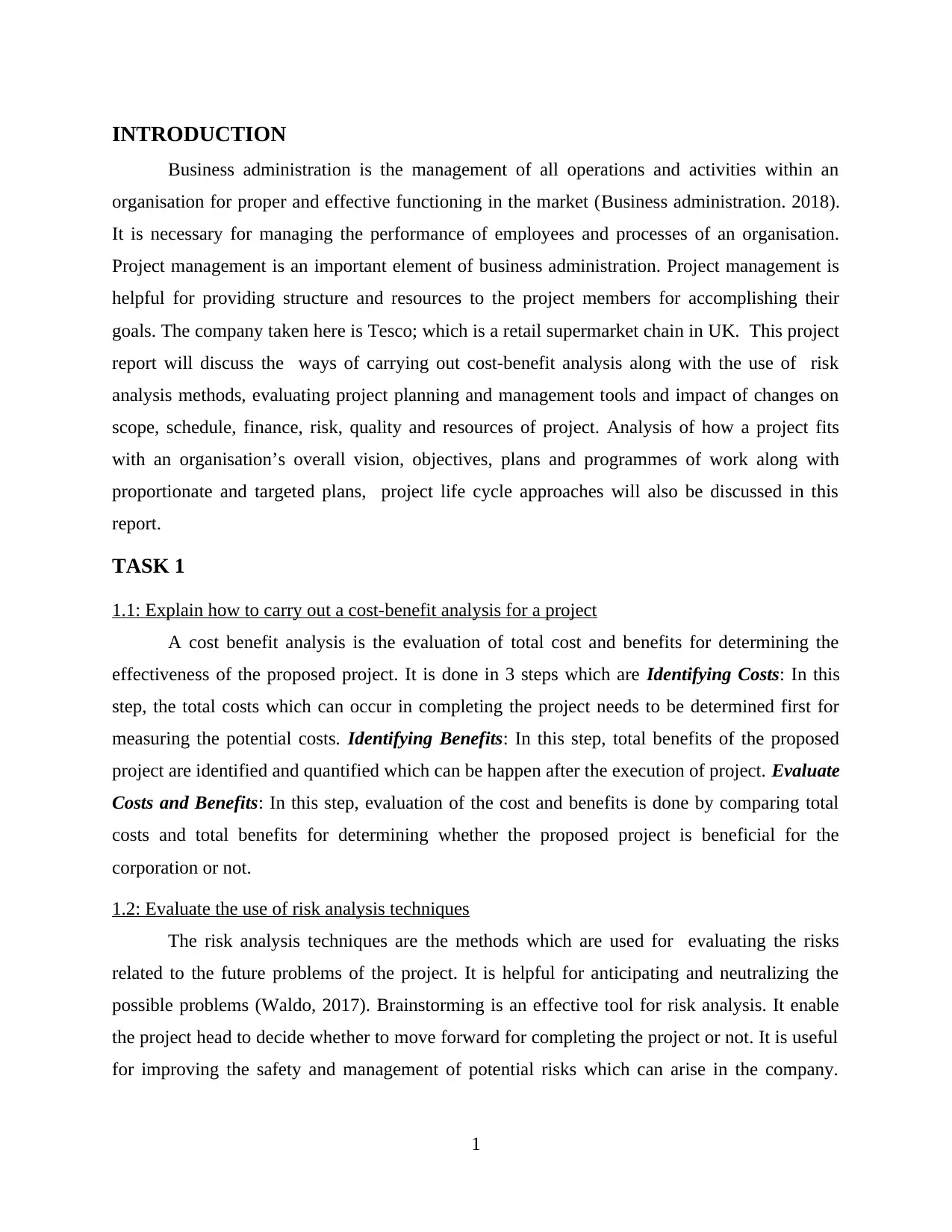
INTRODUCTION
Business administration is the management of all operations and activities within an
organisation for proper and effective functioning in the market (Business administration. 2018).
It is necessary for managing the performance of employees and processes of an organisation.
Project management is an important element of business administration. Project management is
helpful for providing structure and resources to the project members for accomplishing their
goals. The company taken here is Tesco; which is a retail supermarket chain in UK. This project
report will discuss the ways of carrying out cost-benefit analysis along with the use of risk
analysis methods, evaluating project planning and management tools and impact of changes on
scope, schedule, finance, risk, quality and resources of project. Analysis of how a project fits
with an organisation’s overall vision, objectives, plans and programmes of work along with
proportionate and targeted plans, project life cycle approaches will also be discussed in this
report.
TASK 1
1.1: Explain how to carry out a cost-benefit analysis for a project
A cost benefit analysis is the evaluation of total cost and benefits for determining the
effectiveness of the proposed project. It is done in 3 steps which are Identifying Costs: In this
step, the total costs which can occur in completing the project needs to be determined first for
measuring the potential costs. Identifying Benefits: In this step, total benefits of the proposed
project are identified and quantified which can be happen after the execution of project. Evaluate
Costs and Benefits: In this step, evaluation of the cost and benefits is done by comparing total
costs and total benefits for determining whether the proposed project is beneficial for the
corporation or not.
1.2: Evaluate the use of risk analysis techniques
The risk analysis techniques are the methods which are used for evaluating the risks
related to the future problems of the project. It is helpful for anticipating and neutralizing the
possible problems (Waldo, 2017). Brainstorming is an effective tool for risk analysis. It enable
the project head to decide whether to move forward for completing the project or not. It is useful
for improving the safety and management of potential risks which can arise in the company.
1
Business administration is the management of all operations and activities within an
organisation for proper and effective functioning in the market (Business administration. 2018).
It is necessary for managing the performance of employees and processes of an organisation.
Project management is an important element of business administration. Project management is
helpful for providing structure and resources to the project members for accomplishing their
goals. The company taken here is Tesco; which is a retail supermarket chain in UK. This project
report will discuss the ways of carrying out cost-benefit analysis along with the use of risk
analysis methods, evaluating project planning and management tools and impact of changes on
scope, schedule, finance, risk, quality and resources of project. Analysis of how a project fits
with an organisation’s overall vision, objectives, plans and programmes of work along with
proportionate and targeted plans, project life cycle approaches will also be discussed in this
report.
TASK 1
1.1: Explain how to carry out a cost-benefit analysis for a project
A cost benefit analysis is the evaluation of total cost and benefits for determining the
effectiveness of the proposed project. It is done in 3 steps which are Identifying Costs: In this
step, the total costs which can occur in completing the project needs to be determined first for
measuring the potential costs. Identifying Benefits: In this step, total benefits of the proposed
project are identified and quantified which can be happen after the execution of project. Evaluate
Costs and Benefits: In this step, evaluation of the cost and benefits is done by comparing total
costs and total benefits for determining whether the proposed project is beneficial for the
corporation or not.
1.2: Evaluate the use of risk analysis techniques
The risk analysis techniques are the methods which are used for evaluating the risks
related to the future problems of the project. It is helpful for anticipating and neutralizing the
possible problems (Waldo, 2017). Brainstorming is an effective tool for risk analysis. It enable
the project head to decide whether to move forward for completing the project or not. It is useful
for improving the safety and management of potential risks which can arise in the company.
1
Paraphrase This Document
Need a fresh take? Get an instant paraphrase of this document with our AI Paraphraser
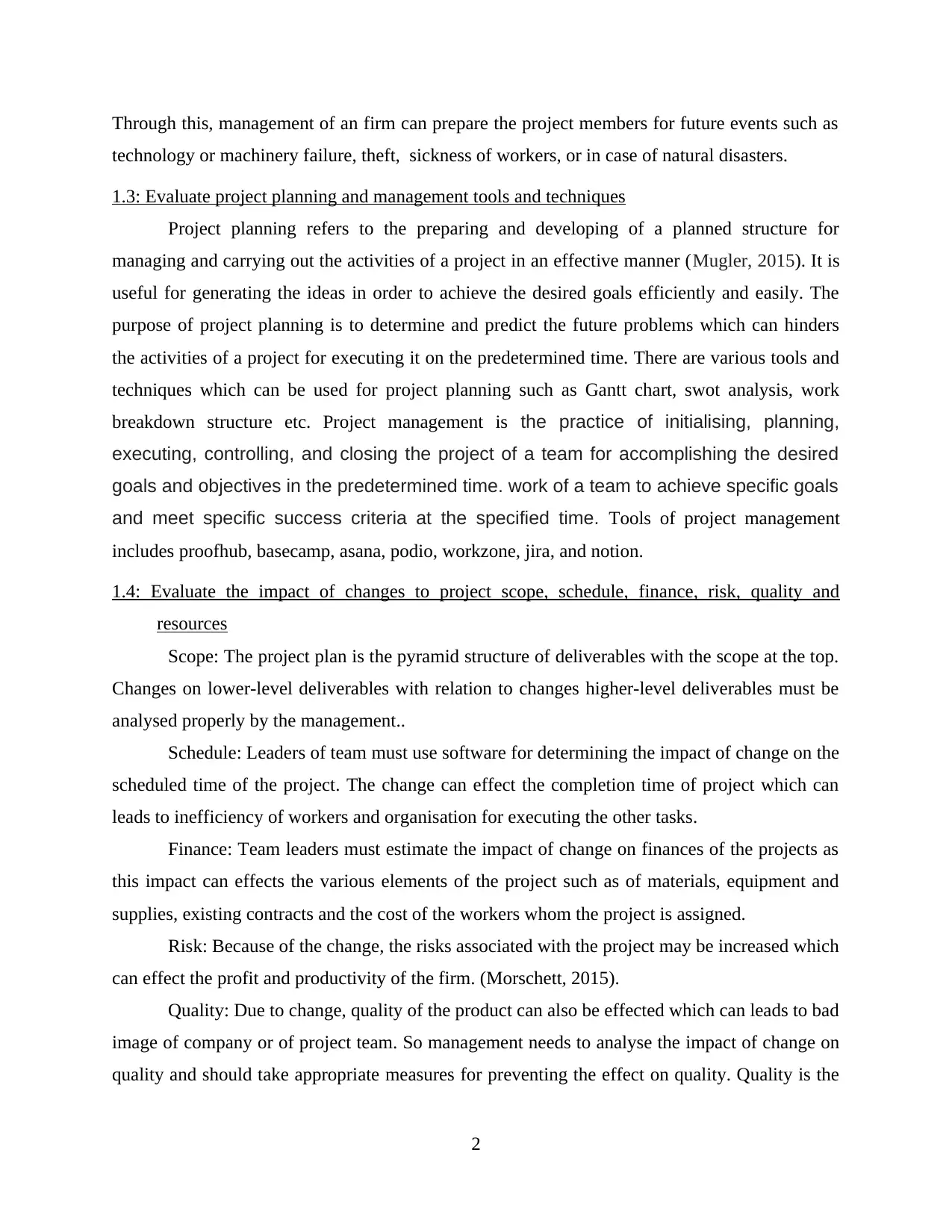
Through this, management of an firm can prepare the project members for future events such as
technology or machinery failure, theft, sickness of workers, or in case of natural disasters.
1.3: Evaluate project planning and management tools and techniques
Project planning refers to the preparing and developing of a planned structure for
managing and carrying out the activities of a project in an effective manner (Mugler, 2015). It is
useful for generating the ideas in order to achieve the desired goals efficiently and easily. The
purpose of project planning is to determine and predict the future problems which can hinders
the activities of a project for executing it on the predetermined time. There are various tools and
techniques which can be used for project planning such as Gantt chart, swot analysis, work
breakdown structure etc. Project management is the practice of initialising, planning,
executing, controlling, and closing the project of a team for accomplishing the desired
goals and objectives in the predetermined time. work of a team to achieve specific goals
and meet specific success criteria at the specified time. Tools of project management
includes proofhub, basecamp, asana, podio, workzone, jira, and notion.
1.4: Evaluate the impact of changes to project scope, schedule, finance, risk, quality and
resources
Scope: The project plan is the pyramid structure of deliverables with the scope at the top.
Changes on lower-level deliverables with relation to changes higher-level deliverables must be
analysed properly by the management..
Schedule: Leaders of team must use software for determining the impact of change on the
scheduled time of the project. The change can effect the completion time of project which can
leads to inefficiency of workers and organisation for executing the other tasks.
Finance: Team leaders must estimate the impact of change on finances of the projects as
this impact can effects the various elements of the project such as of materials, equipment and
supplies, existing contracts and the cost of the workers whom the project is assigned.
Risk: Because of the change, the risks associated with the project may be increased which
can effect the profit and productivity of the firm. (Morschett, 2015).
Quality: Due to change, quality of the product can also be effected which can leads to bad
image of company or of project team. So management needs to analyse the impact of change on
quality and should take appropriate measures for preventing the effect on quality. Quality is the
2
technology or machinery failure, theft, sickness of workers, or in case of natural disasters.
1.3: Evaluate project planning and management tools and techniques
Project planning refers to the preparing and developing of a planned structure for
managing and carrying out the activities of a project in an effective manner (Mugler, 2015). It is
useful for generating the ideas in order to achieve the desired goals efficiently and easily. The
purpose of project planning is to determine and predict the future problems which can hinders
the activities of a project for executing it on the predetermined time. There are various tools and
techniques which can be used for project planning such as Gantt chart, swot analysis, work
breakdown structure etc. Project management is the practice of initialising, planning,
executing, controlling, and closing the project of a team for accomplishing the desired
goals and objectives in the predetermined time. work of a team to achieve specific goals
and meet specific success criteria at the specified time. Tools of project management
includes proofhub, basecamp, asana, podio, workzone, jira, and notion.
1.4: Evaluate the impact of changes to project scope, schedule, finance, risk, quality and
resources
Scope: The project plan is the pyramid structure of deliverables with the scope at the top.
Changes on lower-level deliverables with relation to changes higher-level deliverables must be
analysed properly by the management..
Schedule: Leaders of team must use software for determining the impact of change on the
scheduled time of the project. The change can effect the completion time of project which can
leads to inefficiency of workers and organisation for executing the other tasks.
Finance: Team leaders must estimate the impact of change on finances of the projects as
this impact can effects the various elements of the project such as of materials, equipment and
supplies, existing contracts and the cost of the workers whom the project is assigned.
Risk: Because of the change, the risks associated with the project may be increased which
can effect the profit and productivity of the firm. (Morschett, 2015).
Quality: Due to change, quality of the product can also be effected which can leads to bad
image of company or of project team. So management needs to analyse the impact of change on
quality and should take appropriate measures for preventing the effect on quality. Quality is the
2
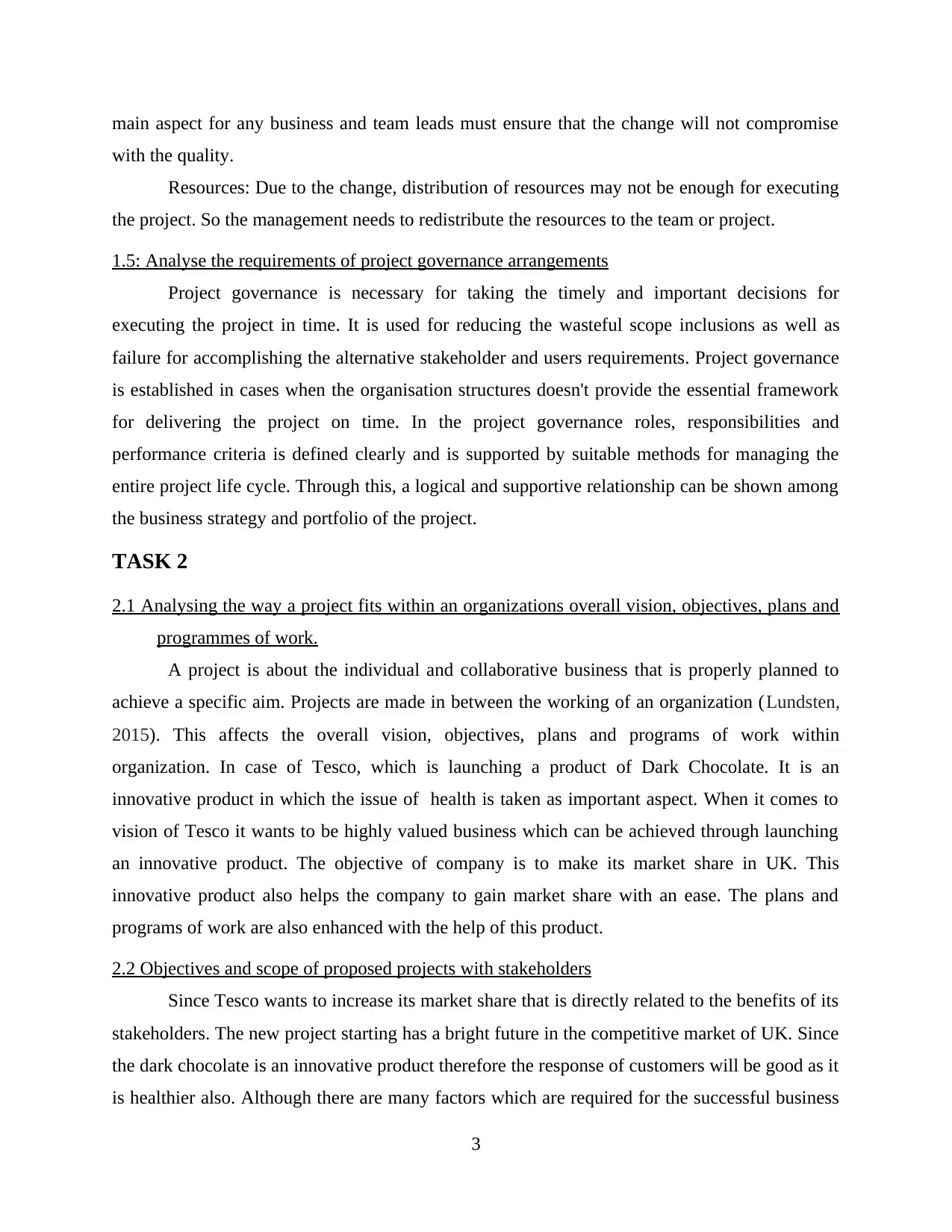
main aspect for any business and team leads must ensure that the change will not compromise
with the quality.
Resources: Due to the change, distribution of resources may not be enough for executing
the project. So the management needs to redistribute the resources to the team or project.
1.5: Analyse the requirements of project governance arrangements
Project governance is necessary for taking the timely and important decisions for
executing the project in time. It is used for reducing the wasteful scope inclusions as well as
failure for accomplishing the alternative stakeholder and users requirements. Project governance
is established in cases when the organisation structures doesn't provide the essential framework
for delivering the project on time. In the project governance roles, responsibilities and
performance criteria is defined clearly and is supported by suitable methods for managing the
entire project life cycle. Through this, a logical and supportive relationship can be shown among
the business strategy and portfolio of the project.
TASK 2
2.1 Analysing the way a project fits within an organizations overall vision, objectives, plans and
programmes of work.
A project is about the individual and collaborative business that is properly planned to
achieve a specific aim. Projects are made in between the working of an organization (Lundsten,
2015). This affects the overall vision, objectives, plans and programs of work within
organization. In case of Tesco, which is launching a product of Dark Chocolate. It is an
innovative product in which the issue of health is taken as important aspect. When it comes to
vision of Tesco it wants to be highly valued business which can be achieved through launching
an innovative product. The objective of company is to make its market share in UK. This
innovative product also helps the company to gain market share with an ease. The plans and
programs of work are also enhanced with the help of this product.
2.2 Objectives and scope of proposed projects with stakeholders
Since Tesco wants to increase its market share that is directly related to the benefits of its
stakeholders. The new project starting has a bright future in the competitive market of UK. Since
the dark chocolate is an innovative product therefore the response of customers will be good as it
is healthier also. Although there are many factors which are required for the successful business
3
with the quality.
Resources: Due to the change, distribution of resources may not be enough for executing
the project. So the management needs to redistribute the resources to the team or project.
1.5: Analyse the requirements of project governance arrangements
Project governance is necessary for taking the timely and important decisions for
executing the project in time. It is used for reducing the wasteful scope inclusions as well as
failure for accomplishing the alternative stakeholder and users requirements. Project governance
is established in cases when the organisation structures doesn't provide the essential framework
for delivering the project on time. In the project governance roles, responsibilities and
performance criteria is defined clearly and is supported by suitable methods for managing the
entire project life cycle. Through this, a logical and supportive relationship can be shown among
the business strategy and portfolio of the project.
TASK 2
2.1 Analysing the way a project fits within an organizations overall vision, objectives, plans and
programmes of work.
A project is about the individual and collaborative business that is properly planned to
achieve a specific aim. Projects are made in between the working of an organization (Lundsten,
2015). This affects the overall vision, objectives, plans and programs of work within
organization. In case of Tesco, which is launching a product of Dark Chocolate. It is an
innovative product in which the issue of health is taken as important aspect. When it comes to
vision of Tesco it wants to be highly valued business which can be achieved through launching
an innovative product. The objective of company is to make its market share in UK. This
innovative product also helps the company to gain market share with an ease. The plans and
programs of work are also enhanced with the help of this product.
2.2 Objectives and scope of proposed projects with stakeholders
Since Tesco wants to increase its market share that is directly related to the benefits of its
stakeholders. The new project starting has a bright future in the competitive market of UK. Since
the dark chocolate is an innovative product therefore the response of customers will be good as it
is healthier also. Although there are many factors which are required for the successful business
3
⊘ This is a preview!⊘
Do you want full access?
Subscribe today to unlock all pages.

Trusted by 1+ million students worldwide
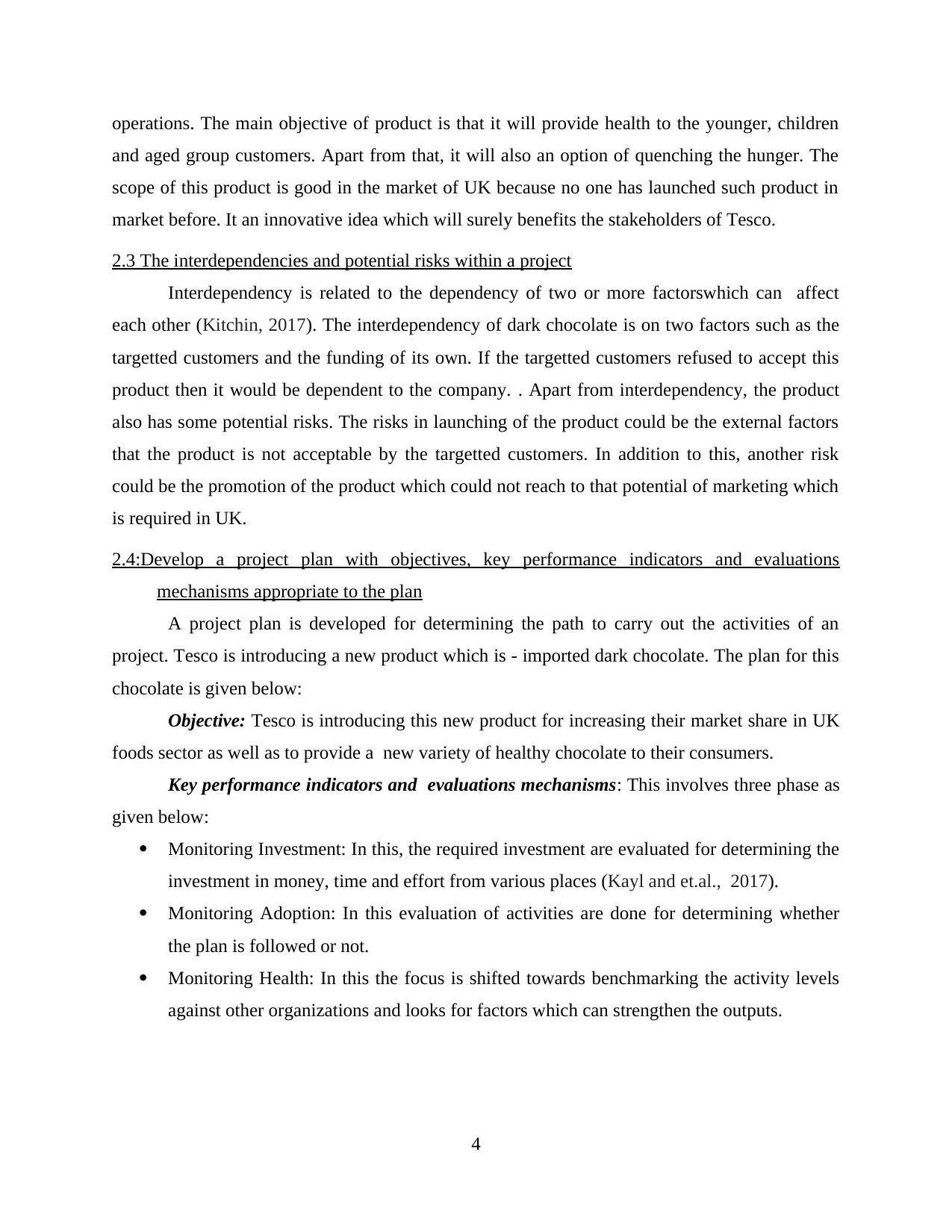
operations. The main objective of product is that it will provide health to the younger, children
and aged group customers. Apart from that, it will also an option of quenching the hunger. The
scope of this product is good in the market of UK because no one has launched such product in
market before. It an innovative idea which will surely benefits the stakeholders of Tesco.
2.3 The interdependencies and potential risks within a project
Interdependency is related to the dependency of two or more factorswhich can affect
each other (Kitchin, 2017). The interdependency of dark chocolate is on two factors such as the
targetted customers and the funding of its own. If the targetted customers refused to accept this
product then it would be dependent to the company. . Apart from interdependency, the product
also has some potential risks. The risks in launching of the product could be the external factors
that the product is not acceptable by the targetted customers. In addition to this, another risk
could be the promotion of the product which could not reach to that potential of marketing which
is required in UK.
2.4:Develop a project plan with objectives, key performance indicators and evaluations
mechanisms appropriate to the plan
A project plan is developed for determining the path to carry out the activities of an
project. Tesco is introducing a new product which is - imported dark chocolate. The plan for this
chocolate is given below:
Objective: Tesco is introducing this new product for increasing their market share in UK
foods sector as well as to provide a new variety of healthy chocolate to their consumers.
Key performance indicators and evaluations mechanisms: This involves three phase as
given below:
Monitoring Investment: In this, the required investment are evaluated for determining the
investment in money, time and effort from various places (Kayl and et.al., 2017).
Monitoring Adoption: In this evaluation of activities are done for determining whether
the plan is followed or not.
Monitoring Health: In this the focus is shifted towards benchmarking the activity levels
against other organizations and looks for factors which can strengthen the outputs.
4
and aged group customers. Apart from that, it will also an option of quenching the hunger. The
scope of this product is good in the market of UK because no one has launched such product in
market before. It an innovative idea which will surely benefits the stakeholders of Tesco.
2.3 The interdependencies and potential risks within a project
Interdependency is related to the dependency of two or more factorswhich can affect
each other (Kitchin, 2017). The interdependency of dark chocolate is on two factors such as the
targetted customers and the funding of its own. If the targetted customers refused to accept this
product then it would be dependent to the company. . Apart from interdependency, the product
also has some potential risks. The risks in launching of the product could be the external factors
that the product is not acceptable by the targetted customers. In addition to this, another risk
could be the promotion of the product which could not reach to that potential of marketing which
is required in UK.
2.4:Develop a project plan with objectives, key performance indicators and evaluations
mechanisms appropriate to the plan
A project plan is developed for determining the path to carry out the activities of an
project. Tesco is introducing a new product which is - imported dark chocolate. The plan for this
chocolate is given below:
Objective: Tesco is introducing this new product for increasing their market share in UK
foods sector as well as to provide a new variety of healthy chocolate to their consumers.
Key performance indicators and evaluations mechanisms: This involves three phase as
given below:
Monitoring Investment: In this, the required investment are evaluated for determining the
investment in money, time and effort from various places (Kayl and et.al., 2017).
Monitoring Adoption: In this evaluation of activities are done for determining whether
the plan is followed or not.
Monitoring Health: In this the focus is shifted towards benchmarking the activity levels
against other organizations and looks for factors which can strengthen the outputs.
4
Paraphrase This Document
Need a fresh take? Get an instant paraphrase of this document with our AI Paraphraser
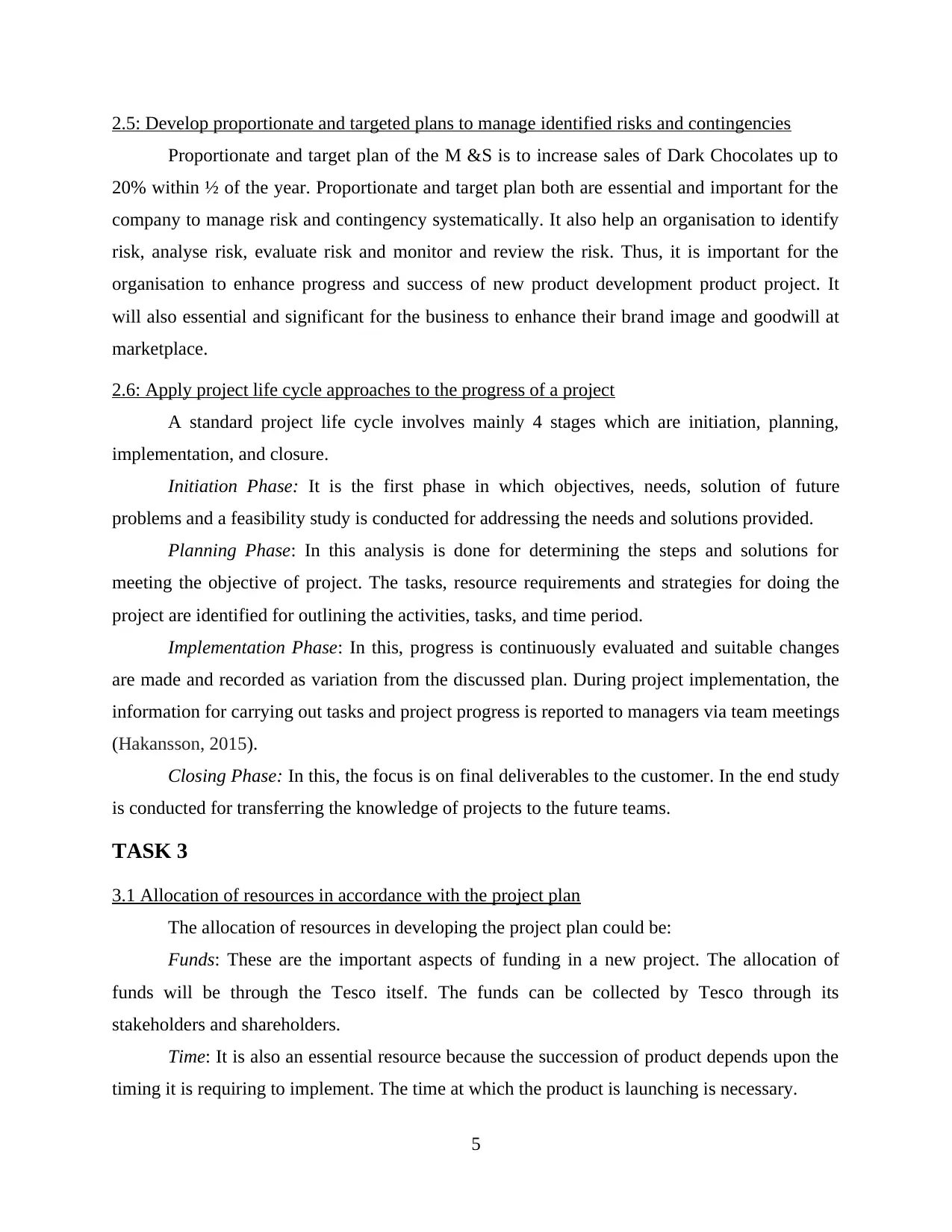
2.5: Develop proportionate and targeted plans to manage identified risks and contingencies
Proportionate and target plan of the M &S is to increase sales of Dark Chocolates up to
20% within ½ of the year. Proportionate and target plan both are essential and important for the
company to manage risk and contingency systematically. It also help an organisation to identify
risk, analyse risk, evaluate risk and monitor and review the risk. Thus, it is important for the
organisation to enhance progress and success of new product development product project. It
will also essential and significant for the business to enhance their brand image and goodwill at
marketplace.
2.6: Apply project life cycle approaches to the progress of a project
A standard project life cycle involves mainly 4 stages which are initiation, planning,
implementation, and closure.
Initiation Phase: It is the first phase in which objectives, needs, solution of future
problems and a feasibility study is conducted for addressing the needs and solutions provided.
Planning Phase: In this analysis is done for determining the steps and solutions for
meeting the objective of project. The tasks, resource requirements and strategies for doing the
project are identified for outlining the activities, tasks, and time period.
Implementation Phase: In this, progress is continuously evaluated and suitable changes
are made and recorded as variation from the discussed plan. During project implementation, the
information for carrying out tasks and project progress is reported to managers via team meetings
(Hakansson, 2015).
Closing Phase: In this, the focus is on final deliverables to the customer. In the end study
is conducted for transferring the knowledge of projects to the future teams.
TASK 3
3.1 Allocation of resources in accordance with the project plan
The allocation of resources in developing the project plan could be:
Funds: These are the important aspects of funding in a new project. The allocation of
funds will be through the Tesco itself. The funds can be collected by Tesco through its
stakeholders and shareholders.
Time: It is also an essential resource because the succession of product depends upon the
timing it is requiring to implement. The time at which the product is launching is necessary.
5
Proportionate and target plan of the M &S is to increase sales of Dark Chocolates up to
20% within ½ of the year. Proportionate and target plan both are essential and important for the
company to manage risk and contingency systematically. It also help an organisation to identify
risk, analyse risk, evaluate risk and monitor and review the risk. Thus, it is important for the
organisation to enhance progress and success of new product development product project. It
will also essential and significant for the business to enhance their brand image and goodwill at
marketplace.
2.6: Apply project life cycle approaches to the progress of a project
A standard project life cycle involves mainly 4 stages which are initiation, planning,
implementation, and closure.
Initiation Phase: It is the first phase in which objectives, needs, solution of future
problems and a feasibility study is conducted for addressing the needs and solutions provided.
Planning Phase: In this analysis is done for determining the steps and solutions for
meeting the objective of project. The tasks, resource requirements and strategies for doing the
project are identified for outlining the activities, tasks, and time period.
Implementation Phase: In this, progress is continuously evaluated and suitable changes
are made and recorded as variation from the discussed plan. During project implementation, the
information for carrying out tasks and project progress is reported to managers via team meetings
(Hakansson, 2015).
Closing Phase: In this, the focus is on final deliverables to the customer. In the end study
is conducted for transferring the knowledge of projects to the future teams.
TASK 3
3.1 Allocation of resources in accordance with the project plan
The allocation of resources in developing the project plan could be:
Funds: These are the important aspects of funding in a new project. The allocation of
funds will be through the Tesco itself. The funds can be collected by Tesco through its
stakeholders and shareholders.
Time: It is also an essential resource because the succession of product depends upon the
timing it is requiring to implement. The time at which the product is launching is necessary.
5
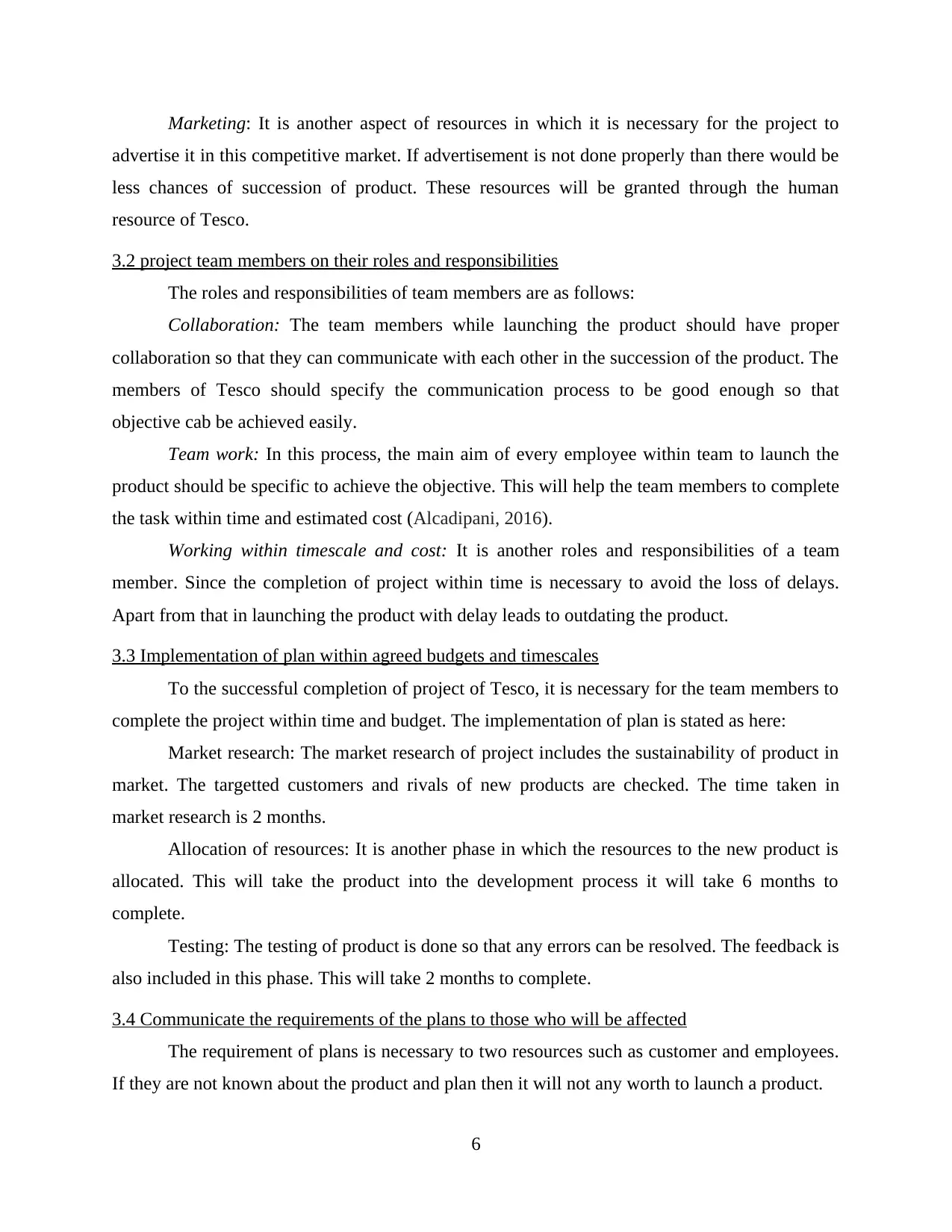
Marketing: It is another aspect of resources in which it is necessary for the project to
advertise it in this competitive market. If advertisement is not done properly than there would be
less chances of succession of product. These resources will be granted through the human
resource of Tesco.
3.2 project team members on their roles and responsibilities
The roles and responsibilities of team members are as follows:
Collaboration: The team members while launching the product should have proper
collaboration so that they can communicate with each other in the succession of the product. The
members of Tesco should specify the communication process to be good enough so that
objective cab be achieved easily.
Team work: In this process, the main aim of every employee within team to launch the
product should be specific to achieve the objective. This will help the team members to complete
the task within time and estimated cost (Alcadipani, 2016).
Working within timescale and cost: It is another roles and responsibilities of a team
member. Since the completion of project within time is necessary to avoid the loss of delays.
Apart from that in launching the product with delay leads to outdating the product.
3.3 Implementation of plan within agreed budgets and timescales
To the successful completion of project of Tesco, it is necessary for the team members to
complete the project within time and budget. The implementation of plan is stated as here:
Market research: The market research of project includes the sustainability of product in
market. The targetted customers and rivals of new products are checked. The time taken in
market research is 2 months.
Allocation of resources: It is another phase in which the resources to the new product is
allocated. This will take the product into the development process it will take 6 months to
complete.
Testing: The testing of product is done so that any errors can be resolved. The feedback is
also included in this phase. This will take 2 months to complete.
3.4 Communicate the requirements of the plans to those who will be affected
The requirement of plans is necessary to two resources such as customer and employees.
If they are not known about the product and plan then it will not any worth to launch a product.
6
advertise it in this competitive market. If advertisement is not done properly than there would be
less chances of succession of product. These resources will be granted through the human
resource of Tesco.
3.2 project team members on their roles and responsibilities
The roles and responsibilities of team members are as follows:
Collaboration: The team members while launching the product should have proper
collaboration so that they can communicate with each other in the succession of the product. The
members of Tesco should specify the communication process to be good enough so that
objective cab be achieved easily.
Team work: In this process, the main aim of every employee within team to launch the
product should be specific to achieve the objective. This will help the team members to complete
the task within time and estimated cost (Alcadipani, 2016).
Working within timescale and cost: It is another roles and responsibilities of a team
member. Since the completion of project within time is necessary to avoid the loss of delays.
Apart from that in launching the product with delay leads to outdating the product.
3.3 Implementation of plan within agreed budgets and timescales
To the successful completion of project of Tesco, it is necessary for the team members to
complete the project within time and budget. The implementation of plan is stated as here:
Market research: The market research of project includes the sustainability of product in
market. The targetted customers and rivals of new products are checked. The time taken in
market research is 2 months.
Allocation of resources: It is another phase in which the resources to the new product is
allocated. This will take the product into the development process it will take 6 months to
complete.
Testing: The testing of product is done so that any errors can be resolved. The feedback is
also included in this phase. This will take 2 months to complete.
3.4 Communicate the requirements of the plans to those who will be affected
The requirement of plans is necessary to two resources such as customer and employees.
If they are not known about the product and plan then it will not any worth to launch a product.
6
⊘ This is a preview!⊘
Do you want full access?
Subscribe today to unlock all pages.

Trusted by 1+ million students worldwide
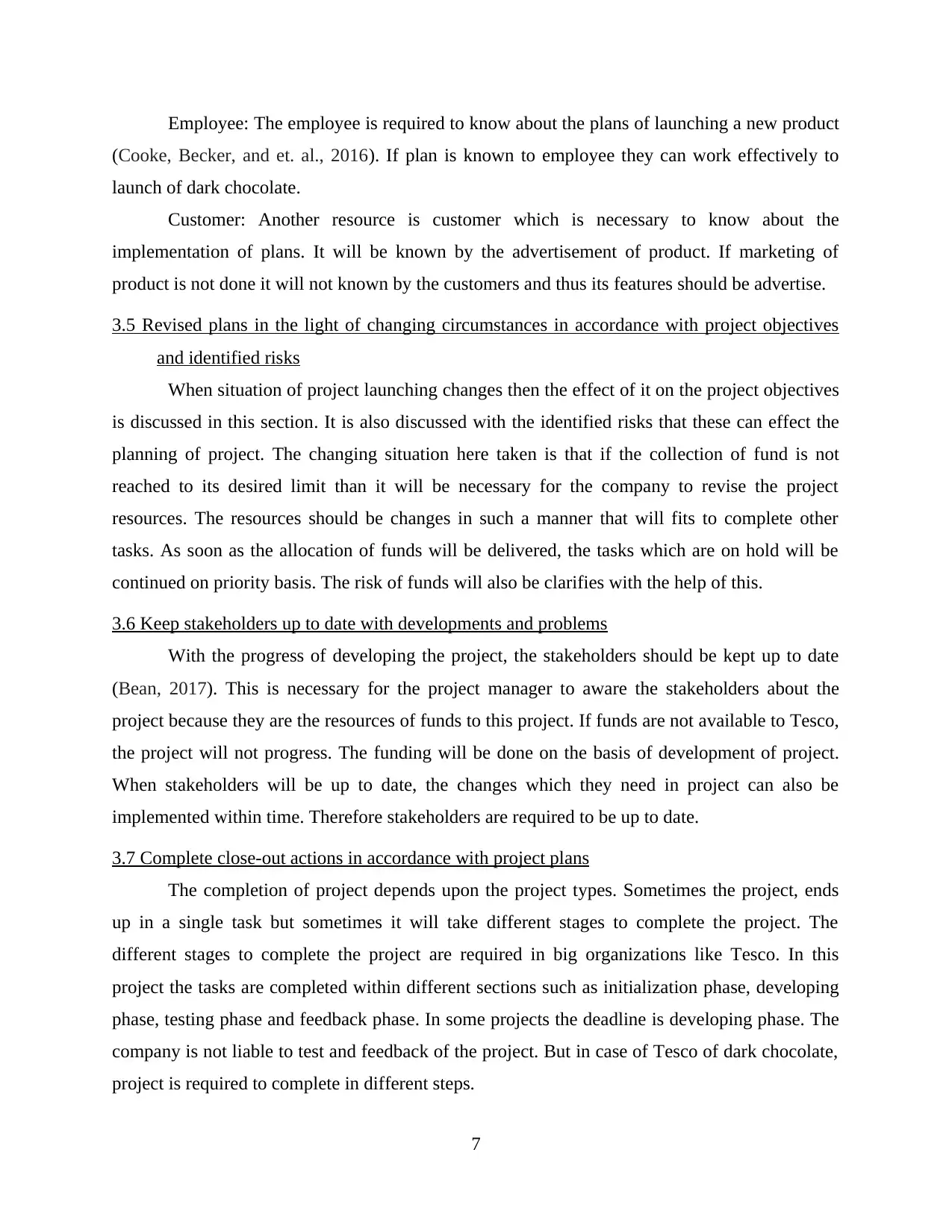
Employee: The employee is required to know about the plans of launching a new product
(Cooke, Becker, and et. al., 2016). If plan is known to employee they can work effectively to
launch of dark chocolate.
Customer: Another resource is customer which is necessary to know about the
implementation of plans. It will be known by the advertisement of product. If marketing of
product is not done it will not known by the customers and thus its features should be advertise.
3.5 Revised plans in the light of changing circumstances in accordance with project objectives
and identified risks
When situation of project launching changes then the effect of it on the project objectives
is discussed in this section. It is also discussed with the identified risks that these can effect the
planning of project. The changing situation here taken is that if the collection of fund is not
reached to its desired limit than it will be necessary for the company to revise the project
resources. The resources should be changes in such a manner that will fits to complete other
tasks. As soon as the allocation of funds will be delivered, the tasks which are on hold will be
continued on priority basis. The risk of funds will also be clarifies with the help of this.
3.6 Keep stakeholders up to date with developments and problems
With the progress of developing the project, the stakeholders should be kept up to date
(Bean, 2017). This is necessary for the project manager to aware the stakeholders about the
project because they are the resources of funds to this project. If funds are not available to Tesco,
the project will not progress. The funding will be done on the basis of development of project.
When stakeholders will be up to date, the changes which they need in project can also be
implemented within time. Therefore stakeholders are required to be up to date.
3.7 Complete close-out actions in accordance with project plans
The completion of project depends upon the project types. Sometimes the project, ends
up in a single task but sometimes it will take different stages to complete the project. The
different stages to complete the project are required in big organizations like Tesco. In this
project the tasks are completed within different sections such as initialization phase, developing
phase, testing phase and feedback phase. In some projects the deadline is developing phase. The
company is not liable to test and feedback of the project. But in case of Tesco of dark chocolate,
project is required to complete in different steps.
7
(Cooke, Becker, and et. al., 2016). If plan is known to employee they can work effectively to
launch of dark chocolate.
Customer: Another resource is customer which is necessary to know about the
implementation of plans. It will be known by the advertisement of product. If marketing of
product is not done it will not known by the customers and thus its features should be advertise.
3.5 Revised plans in the light of changing circumstances in accordance with project objectives
and identified risks
When situation of project launching changes then the effect of it on the project objectives
is discussed in this section. It is also discussed with the identified risks that these can effect the
planning of project. The changing situation here taken is that if the collection of fund is not
reached to its desired limit than it will be necessary for the company to revise the project
resources. The resources should be changes in such a manner that will fits to complete other
tasks. As soon as the allocation of funds will be delivered, the tasks which are on hold will be
continued on priority basis. The risk of funds will also be clarifies with the help of this.
3.6 Keep stakeholders up to date with developments and problems
With the progress of developing the project, the stakeholders should be kept up to date
(Bean, 2017). This is necessary for the project manager to aware the stakeholders about the
project because they are the resources of funds to this project. If funds are not available to Tesco,
the project will not progress. The funding will be done on the basis of development of project.
When stakeholders will be up to date, the changes which they need in project can also be
implemented within time. Therefore stakeholders are required to be up to date.
3.7 Complete close-out actions in accordance with project plans
The completion of project depends upon the project types. Sometimes the project, ends
up in a single task but sometimes it will take different stages to complete the project. The
different stages to complete the project are required in big organizations like Tesco. In this
project the tasks are completed within different sections such as initialization phase, developing
phase, testing phase and feedback phase. In some projects the deadline is developing phase. The
company is not liable to test and feedback of the project. But in case of Tesco of dark chocolate,
project is required to complete in different steps.
7
Paraphrase This Document
Need a fresh take? Get an instant paraphrase of this document with our AI Paraphraser
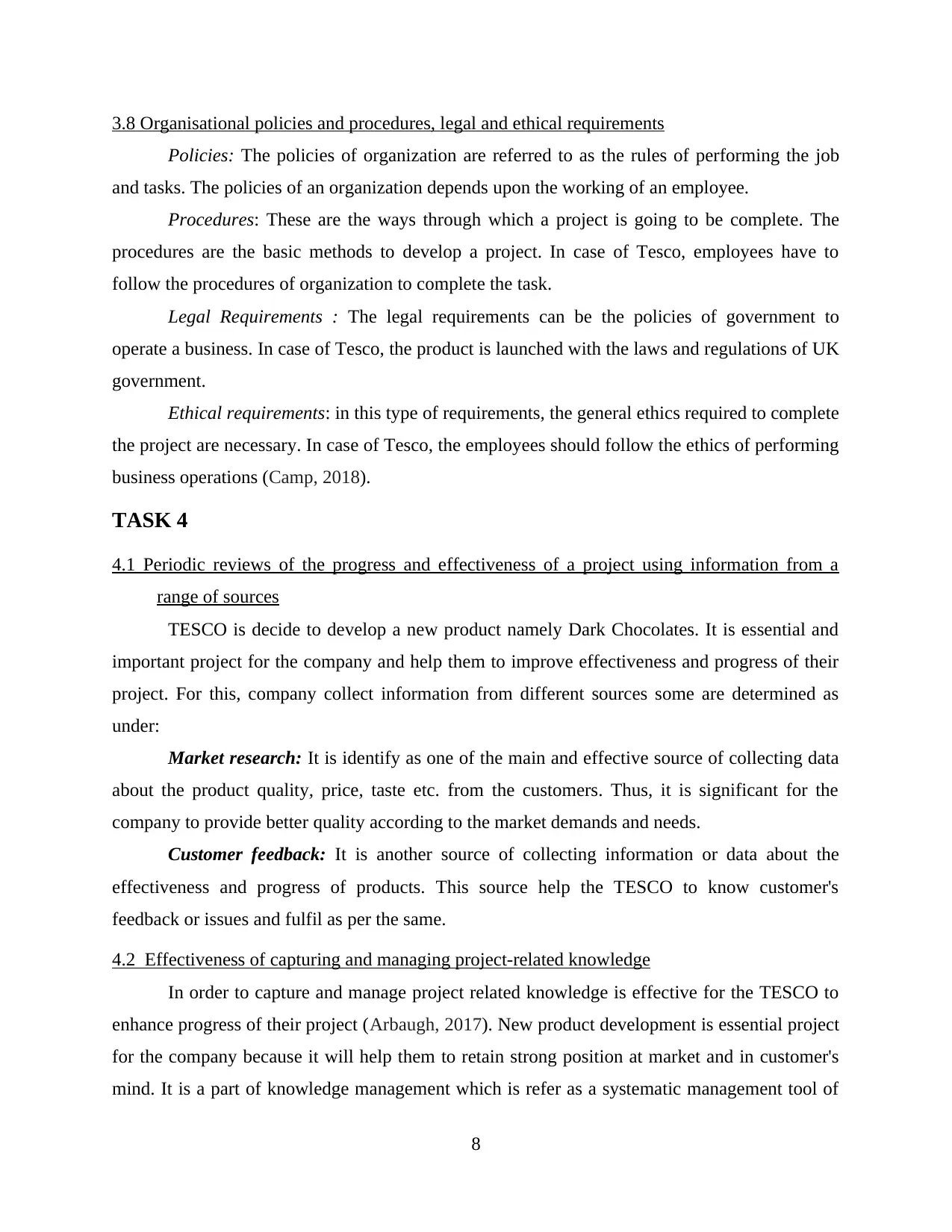
3.8 Organisational policies and procedures, legal and ethical requirements
Policies: The policies of organization are referred to as the rules of performing the job
and tasks. The policies of an organization depends upon the working of an employee.
Procedures: These are the ways through which a project is going to be complete. The
procedures are the basic methods to develop a project. In case of Tesco, employees have to
follow the procedures of organization to complete the task.
Legal Requirements : The legal requirements can be the policies of government to
operate a business. In case of Tesco, the product is launched with the laws and regulations of UK
government.
Ethical requirements: in this type of requirements, the general ethics required to complete
the project are necessary. In case of Tesco, the employees should follow the ethics of performing
business operations (Camp, 2018).
TASK 4
4.1 Periodic reviews of the progress and effectiveness of a project using information from a
range of sources
TESCO is decide to develop a new product namely Dark Chocolates. It is essential and
important project for the company and help them to improve effectiveness and progress of their
project. For this, company collect information from different sources some are determined as
under:
Market research: It is identify as one of the main and effective source of collecting data
about the product quality, price, taste etc. from the customers. Thus, it is significant for the
company to provide better quality according to the market demands and needs.
Customer feedback: It is another source of collecting information or data about the
effectiveness and progress of products. This source help the TESCO to know customer's
feedback or issues and fulfil as per the same.
4.2 Effectiveness of capturing and managing project-related knowledge
In order to capture and manage project related knowledge is effective for the TESCO to
enhance progress of their project (Arbaugh, 2017). New product development is essential project
for the company because it will help them to retain strong position at market and in customer's
mind. It is a part of knowledge management which is refer as a systematic management tool of
8
Policies: The policies of organization are referred to as the rules of performing the job
and tasks. The policies of an organization depends upon the working of an employee.
Procedures: These are the ways through which a project is going to be complete. The
procedures are the basic methods to develop a project. In case of Tesco, employees have to
follow the procedures of organization to complete the task.
Legal Requirements : The legal requirements can be the policies of government to
operate a business. In case of Tesco, the product is launched with the laws and regulations of UK
government.
Ethical requirements: in this type of requirements, the general ethics required to complete
the project are necessary. In case of Tesco, the employees should follow the ethics of performing
business operations (Camp, 2018).
TASK 4
4.1 Periodic reviews of the progress and effectiveness of a project using information from a
range of sources
TESCO is decide to develop a new product namely Dark Chocolates. It is essential and
important project for the company and help them to improve effectiveness and progress of their
project. For this, company collect information from different sources some are determined as
under:
Market research: It is identify as one of the main and effective source of collecting data
about the product quality, price, taste etc. from the customers. Thus, it is significant for the
company to provide better quality according to the market demands and needs.
Customer feedback: It is another source of collecting information or data about the
effectiveness and progress of products. This source help the TESCO to know customer's
feedback or issues and fulfil as per the same.
4.2 Effectiveness of capturing and managing project-related knowledge
In order to capture and manage project related knowledge is effective for the TESCO to
enhance progress of their project (Arbaugh, 2017). New product development is essential project
for the company because it will help them to retain strong position at market and in customer's
mind. It is a part of knowledge management which is refer as a systematic management tool of
8
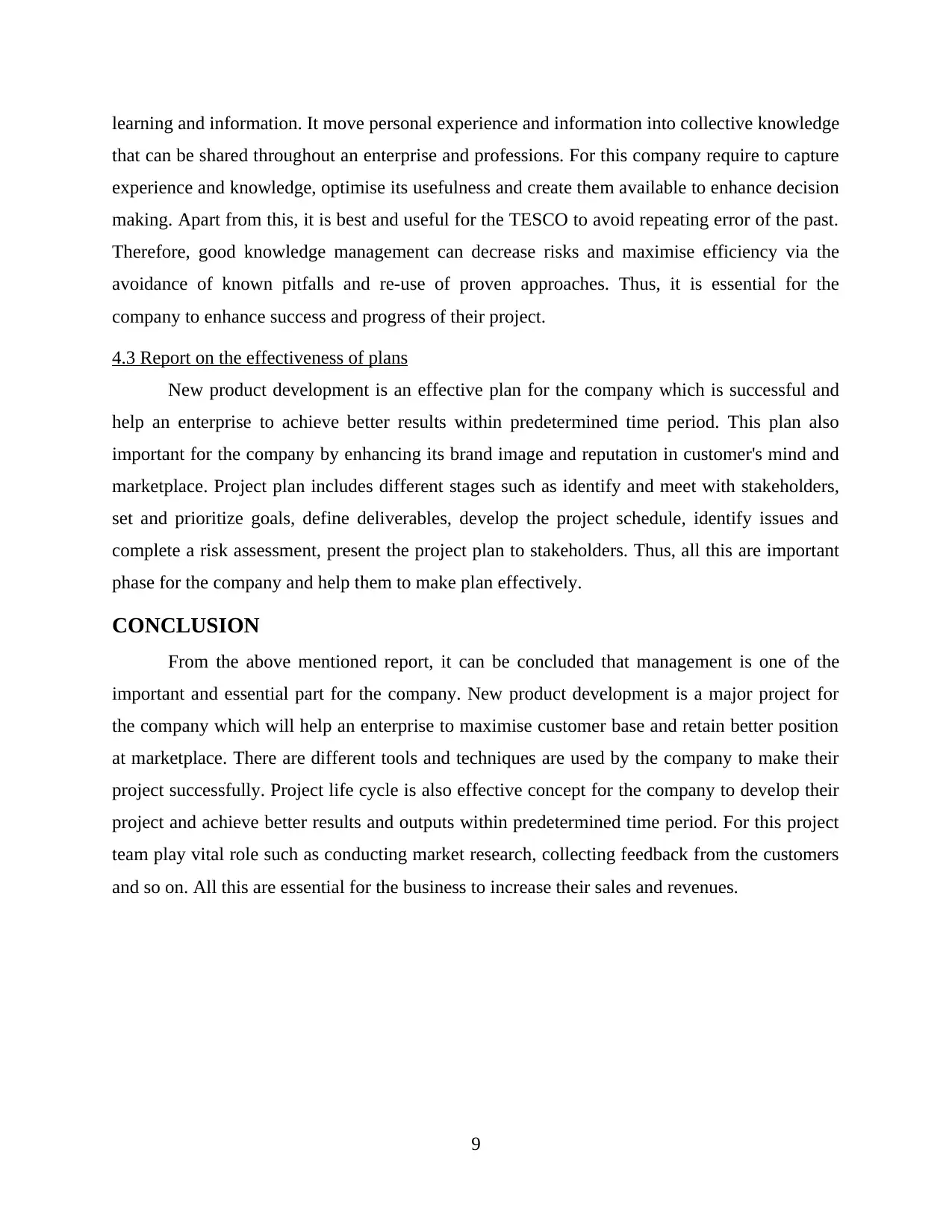
learning and information. It move personal experience and information into collective knowledge
that can be shared throughout an enterprise and professions. For this company require to capture
experience and knowledge, optimise its usefulness and create them available to enhance decision
making. Apart from this, it is best and useful for the TESCO to avoid repeating error of the past.
Therefore, good knowledge management can decrease risks and maximise efficiency via the
avoidance of known pitfalls and re-use of proven approaches. Thus, it is essential for the
company to enhance success and progress of their project.
4.3 Report on the effectiveness of plans
New product development is an effective plan for the company which is successful and
help an enterprise to achieve better results within predetermined time period. This plan also
important for the company by enhancing its brand image and reputation in customer's mind and
marketplace. Project plan includes different stages such as identify and meet with stakeholders,
set and prioritize goals, define deliverables, develop the project schedule, identify issues and
complete a risk assessment, present the project plan to stakeholders. Thus, all this are important
phase for the company and help them to make plan effectively.
CONCLUSION
From the above mentioned report, it can be concluded that management is one of the
important and essential part for the company. New product development is a major project for
the company which will help an enterprise to maximise customer base and retain better position
at marketplace. There are different tools and techniques are used by the company to make their
project successfully. Project life cycle is also effective concept for the company to develop their
project and achieve better results and outputs within predetermined time period. For this project
team play vital role such as conducting market research, collecting feedback from the customers
and so on. All this are essential for the business to increase their sales and revenues.
9
that can be shared throughout an enterprise and professions. For this company require to capture
experience and knowledge, optimise its usefulness and create them available to enhance decision
making. Apart from this, it is best and useful for the TESCO to avoid repeating error of the past.
Therefore, good knowledge management can decrease risks and maximise efficiency via the
avoidance of known pitfalls and re-use of proven approaches. Thus, it is essential for the
company to enhance success and progress of their project.
4.3 Report on the effectiveness of plans
New product development is an effective plan for the company which is successful and
help an enterprise to achieve better results within predetermined time period. This plan also
important for the company by enhancing its brand image and reputation in customer's mind and
marketplace. Project plan includes different stages such as identify and meet with stakeholders,
set and prioritize goals, define deliverables, develop the project schedule, identify issues and
complete a risk assessment, present the project plan to stakeholders. Thus, all this are important
phase for the company and help them to make plan effectively.
CONCLUSION
From the above mentioned report, it can be concluded that management is one of the
important and essential part for the company. New product development is a major project for
the company which will help an enterprise to maximise customer base and retain better position
at marketplace. There are different tools and techniques are used by the company to make their
project successfully. Project life cycle is also effective concept for the company to develop their
project and achieve better results and outputs within predetermined time period. For this project
team play vital role such as conducting market research, collecting feedback from the customers
and so on. All this are essential for the business to increase their sales and revenues.
9
⊘ This is a preview!⊘
Do you want full access?
Subscribe today to unlock all pages.

Trusted by 1+ million students worldwide
1 out of 13
Related Documents
Your All-in-One AI-Powered Toolkit for Academic Success.
+13062052269
info@desklib.com
Available 24*7 on WhatsApp / Email
![[object Object]](/_next/static/media/star-bottom.7253800d.svg)
Unlock your academic potential
Copyright © 2020–2025 A2Z Services. All Rights Reserved. Developed and managed by ZUCOL.





